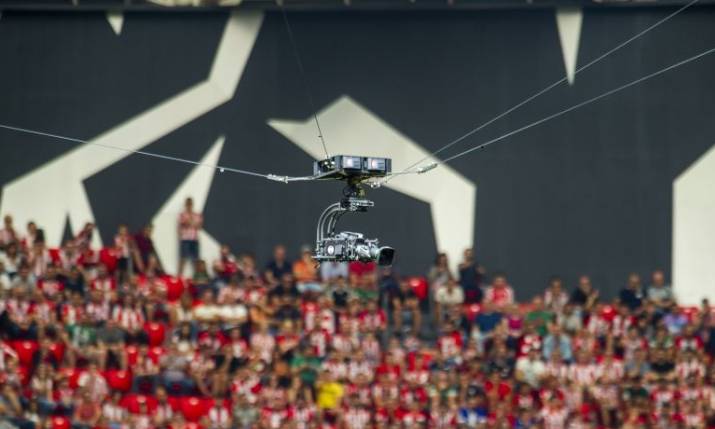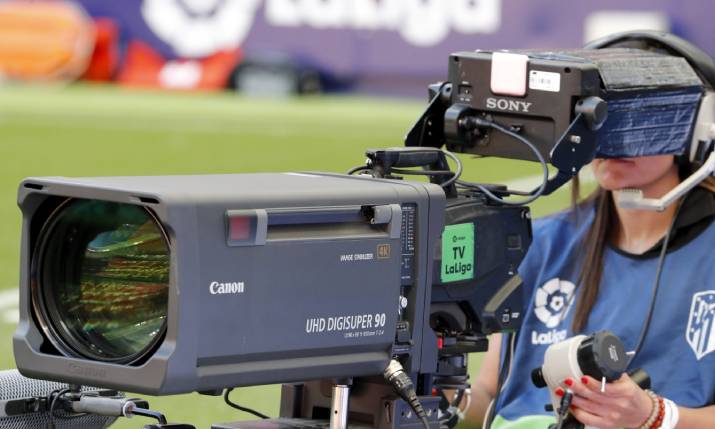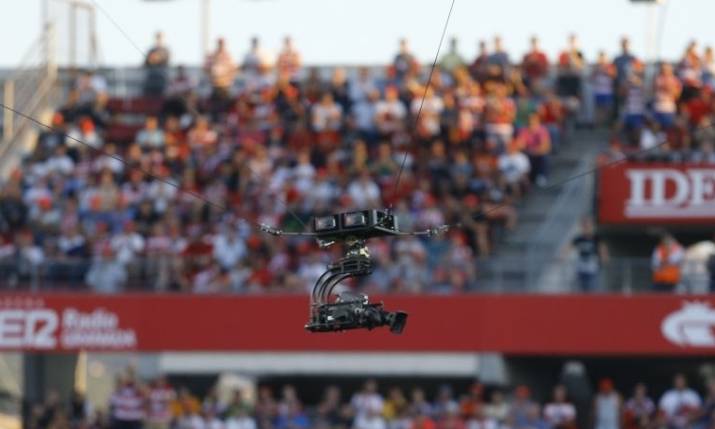Video game angles: Changing League regulations to create LaLiga’s gamified look for the new season

LaLiga is changing how fans of the Spanish football league see their favourite players and teams from the start of its 93rd season, with new cameras, new angles, fresh augmented reality (AR) graphics plus a lot more data, all presented in a gamified way on screen.
Launched to coincide with the opening round of fixtures on 11 August, this is all coming to fruition through LaLiga’s new sponsorship partnership with EA Sports, explains Roger Brosel, head of content at LaLiga.
Speaking to SVG Europe, Brosel says: “After some years with our title sponsor being Banco Santander, so a bank, this season we changed and we’ve got new title sponsor, which is EA Sports. It’s a totally different industry, a totally different association. We’ve always tried to innovate at LaLiga, including newer camera angles, cameras where we’ve never had them before, the aerial cameras, the 360 and all that stuff that we’ve been introducing in LaLiga broadcasts since ’15, ’16.
“However, we felt this was a great turning point to develop that into further innovation together with EA Sports because it made sense since their main product is a football video game, and we’ve always chased those video game angles that seemed impossible 20 years ago. Since our association [with EA Sports] was unveiled, we thought, well, now we’ve got an even bigger opportunity.
“We’ve been collaborating with them very closely, exchanging our ideas and their ideas for the game,” continues Brosel. “Of course, they don’t have any restrictions when it comes to programming their game because it’s an entirely digital environment and we still have bones and flesh and grass and real stands. But for example, the viewers will probably see [the obvious similarities] in a very easy to grasp way with the virtual and the augmented reality graphics [that we are rolling out].
“Those augmented reality graphics are as close as it gets to the video game,” he continues.
Changing regulations
LaLiga is taking the best aspects that the video game version of football offers and trying to bring it to life, using aspects such as camera angles and depth of field to remind viewers of their favourite EA game. On those camera angles, Brosel says: “We’re putting a lot of effort to be able to [create these camera angles in] real life because a lot of young football fans start being football fans while playing a video game; even probably before actually watching 90 minutes of the full game, they start playing the video game and they get used to this visual narrative.
“It’s great aesthetically, but also because it helps the storytelling. It gets you closer to the action. We can incorporate this into our broadcasts and make them more appealing.
“We’re also using the ariel camera in different ways, like placing it a little bit below what we were used to before this season. For example, in the penalties and in the free kicks, the camera goes a little bit down and gets closer to the player, replicating the angle that the players can see in the video game.”
Part of giving fans those new angles on the game has meant that this year LaLiga has actually changed the beautiful game’s regulations in Spain in order for broadcasters, via its technical partner, Mediapro, to get ever closer to the action, both on and off the pitch.
Explains Brosel: “We changed the regulations, which is a really boring thing to do until you get the actual results on camera. This year we’ve changed all the regulations and teams have embraced them really well; I have to say they’ve been fantastic working together with us, because in the end, it’s work that you’ve got to do together with the teams and the players and the managers.

The cinematic cameras being used by LaLiga this season incorporate Canon UHD Digisuper lenses
“Now, in our broadcast in the match feed that we distribute, not only domestically here in Spain, but also internationally, we include shots of dressing rooms before players come out. Also, we do halftime interviews. We get the sound from the cooling breaks, which is really interesting to hear the managers telling players how they need to play in the second half of a game. In post match, we also have a camera inside the dressing room of the team that has won and sometimes do interviews with one of the players inside the dressing room, which is something that we’re not very used to in the world of football, but in the NBA, in the Euro League, they do things like that.”
He adds that LaLiga regularly looks to other leagues and other sports around the world to see what they do in their broadcasts that it could bring to LaLiga fans. “We are always looking at other competitions and whatever they do that is great and that brings more value to the viewer and improves the overall viewing experience of a sport, and we try to incorporate those in LaLiga. Our first match day has been great because we’ve had examples of all these new actions, and we will continue with these in coming match days.”
“In the end, no matter the amount of cameras that you introduce in the broadcast, if you do not have that access, it’s difficult to make [the broadcast] very different. Access in the end is name of the game. If you sit down on a sofa and you want to watch a football game, you know what to expect during the 90 minutes the players are on the pitch. But there’s lots of things that happening around that which are interesting that fans want to see. They’re curious about what happens, like what a manager is telling the players right before they go to the pitch. That’s interesting. And for a football fan, it enhances the experience of sitting down and spending two hours of their life watching LaLiga again.”
Video game angles
Cinematic cameras have been part of LaLiga’s broadcasts for several years but this year the league has stepped up its technology and control of the cameras to create the best version so far, with more control.
The cinematic cameras being used are Sony Venice and Red, which use Canon UHD Digisuper lenses, and incorporate a system called Cinefade, which allows cinematographers to gradually transition between a deep and shallow depth of field in one shot.
Notes Brosel: “The challenge back when we introduced these cameras back in ’21 was first of all, make them work well in a live environment. That was a big challenge with the help of the production company that does LaLiga, which is Mediapro. They worked around a solution to make it be viable to introduce these cameras in live.
“And then we had this issue that since those cameras are very sensitive with the depth of film, it was tricky because you’ve got a player running at you and then the camera goes a bit crazy. But since last season, [Mediapro] managed to make them controlled automatically from the OB truck instead of the operator, which at times was difficult because [players running at them were] getting into their face. Now I think we’ve got a solution that’s very robust, very stable, and we’re very happy with it. It looks fantastic on camera. In the pre-game warm ups, the camera operator is there getting really close shots of the players. Also before the game starts they’re there in the halfway line circle, getting the best shots. It really enhances the experience of watching.”
Comments Brosel on the cinematic camera usage: “We’re using them live as steady cams. The great thing is that we have a lens that allows us to use it as a cinematic camera whenever we want, or as regular broadcast cameras. From the OB truck, the camera control unit (CCU) operator can select whatever look they want to create for that camera. The versatility of it is great.
“The focus thing was a bit tricky at the beginning, but now with these new lenses, it works perfectly and it help us get closer to the action specifically for celebrations. Whenever the footballers hug each other and they’re near the outside lines, the camera can get there. And not only the shot is fantastic, but also the audio is really exciting, to hear how the players are screaming and congratulating each other; the fact that it’s getting so close to the players, it allows us to get that audio very clean.”
LaLiga also ran a test at the end of last season using mini cameras installed on the benches during the final Classico match to capture players reactions at a very close angle throughout the entire game. This was a success so this season, Brosel says, “we’re not making it a one-off, but since it worked so well, we want to do it more regularly for top games”.
He adds: “We use them live whenever there is something relevant, either a goal, a chance, or a controversy, something like that. It enhances the fan’s viewing experience because sometimes as a fan, you want to see how the managers react and how the players react to the main action within the game.”
 Evolution of AR graphics
Evolution of AR graphics
Viewers will see the evolution of the graphics going forward over the rest of the season as LaLiga rolls out more enhancements to it. Brosel comments: “It worked lovely in the first match day. We’ll be incorporating more of these new graphics in upcoming match days because it’s totally, totally new; it’s not a restyling of the older graphics, it’s completely brand new. And we’re introducing more data into it. We’re in our initial stages, and it will get better and better.
“We’ve got more AR graphics in the new graphics package than we had achieved in the previous version of our graphics already. I think it’s the single point that viewers will associate straight away with a video game, especially the ones that we’re using this season, like a circle around the player with their name in it. We really made a lot of effort to make it look like in the video game; we include their individual statistics, sometimes the team statistics, tactical, how the player’s pass the ball or how they’re placed in the field, whether they’re playing 4, 4, 2 or whatever. We’ll be incorporating more of those data points, but yes, we’re very happy the way all these AR graphics have turned out in the broadcast.”

